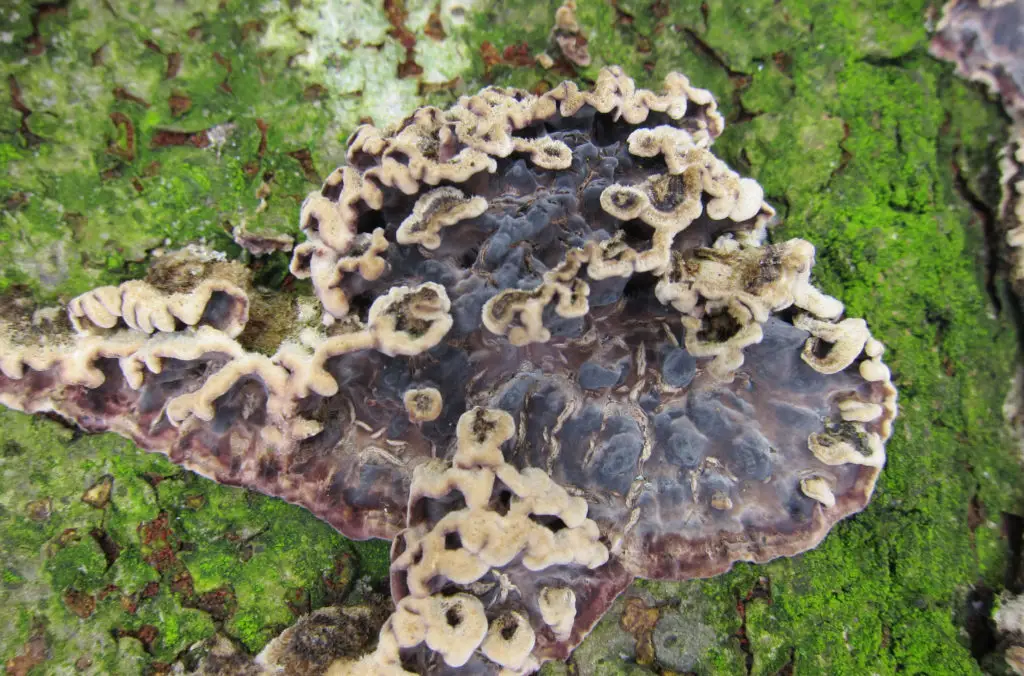Chondrostereum purpureum, better known as silver leaf disease, affects a range of tree varieties. This fungus most commonly affects plums, apples, cherries, and apricots. The infection affects the wood and the leaves of the tree. Any wound in the tree is susceptible to silver leaf and pruning often accelerates the problem.

Henk Monster, CC BY 3.0, via Wikimedia Commons.
Symptoms include leaves adopting a silvery covering, dead branches, and evidence of fungi may be apparent. Sometimes this disease is mistaken for more general wear and tear of your tree.
A Silver leaf infection is often caused by incorrect pruning habits which won’t become apparent until the following fruit season. If you prune incorrectly or during the wrong conditions, it can allow the fungal spores to infect your tree.
Our guide will walk you through identification of this harmful fungus and give tips on treating silver leaf disease.
Jump To...
Silver Leaf Disease Symptoms
A Silver leaf infection is fairly easy to identify. There will be symptoms of the fungus visible on both branches and leaves.
Here’s a few signs of infection to look out for:-
- Leaves may turn a silvery colour. This symptom is most apparent on plum trees, and will be followed by the infected branch dying.
- Irregular dark staining will be visible on the inside of cut branches. This might be apparent during pruning tasks. These stains will give you a positive silver leaf disease identification.
- Fungus may be apparent on older or dead sections of branches – this will be white and wooly in texture on the upper sections. The fungus will have a purple or brown bottom. The fungi is often referred to as fruiting bodies and they can vary a lot in shape and size.
False Silver Leaf
The term false silver leaf is used to describe symptoms similar to the real infection. Your tree leaves may turn silver in colour but this doesn’t mean it’s a case of silver leaf disease.
Other factors such as late frosts can also cause this silver effect and when this occurs most of the leaves will be affected.
If it’s a disease then the silver leaf symptom will be more localised on the damaged branches only until the infection spreads.
Treating Silver leaf Disease
Time is of the essence when treating silver leaf disease. If the infection has spread to the tree trunk itself then this means the entire tree is affected. This often means no treatment is possible by this late stage of infection.
The best method to prevent silver leaf disease involves pruning your fruit tree correctly and at the appropriate times of the year. Watchful maintenance of your fruit trees will keep this fungal infection at bay.
Tips for treating silver leaf disease:-
- Infected wood must be cut back to healthy wood. This potentially involves cutting back a great deal of the tree to get it back to its previous health. You should aim to cut the affected wood back 4–6 inches from where the staining is situated.
- To help prevent silver leaf disease then you must make sure all pruning is carried out correctly at the right time of year for your tree type.
- Any diseased wood you remove should be burnt to avoid reinfestation.
- You can choose to leave the tree in the hope that the problem rectifies itself as it sometimes (inexplicably) does. However, you do run the risk of the disease spreading to other plants and bushes.
- If the disease has spread to the trunk then it’s time to admit defeat and dig out the tree and burn it all including the roots.
- Sterilising all pruning tools after each use can help prevent silver leaf from spreading – very important if you have more than one tree in your garden.
Biology & Lifecycle
Silver leaf can be active at any temperature above freezing and is spread through spores in the wind.
Infected branches will display fungi and this fungi releases spores in the autumn and winter. Any damaged wood can be infected with these spores and it’s why pruning shouldn’t occur during the winter. Fungi forms on stems and branches which starts the lifecycle over again.
Further Reading
The following guides have further information on common infections on trees that can be affected by silver leaf disease.
- See our guide to common plum tree problems for more specific information on diseases suffered by these fruit trees.
- Our apple tree guide will help you diagnose any infections or infestations on your apples.
Silver Leaf FAQ
Got some more queries about treating this potentially tree killing fungal disease? We’ve got the answers to the most commonly asked questions right here!
Time is of the essence to get rid of silver leaf. You must prune away infected branches before infection spreads to the tree trunk. This should not be done in winter, or your efforts may make things worse. Once the disease has gotten into the main trunk, the tree will need to be cut down and the wood disposed of away from your garden, or burned.
Silver leaf is a fungal disease which is caused by the pathogen Chondrostereum Purpureum. Plum trees are particularly vulnerable to the fungal infection. It will also infect most species of the Rosaceae family, also known as the rose family.




